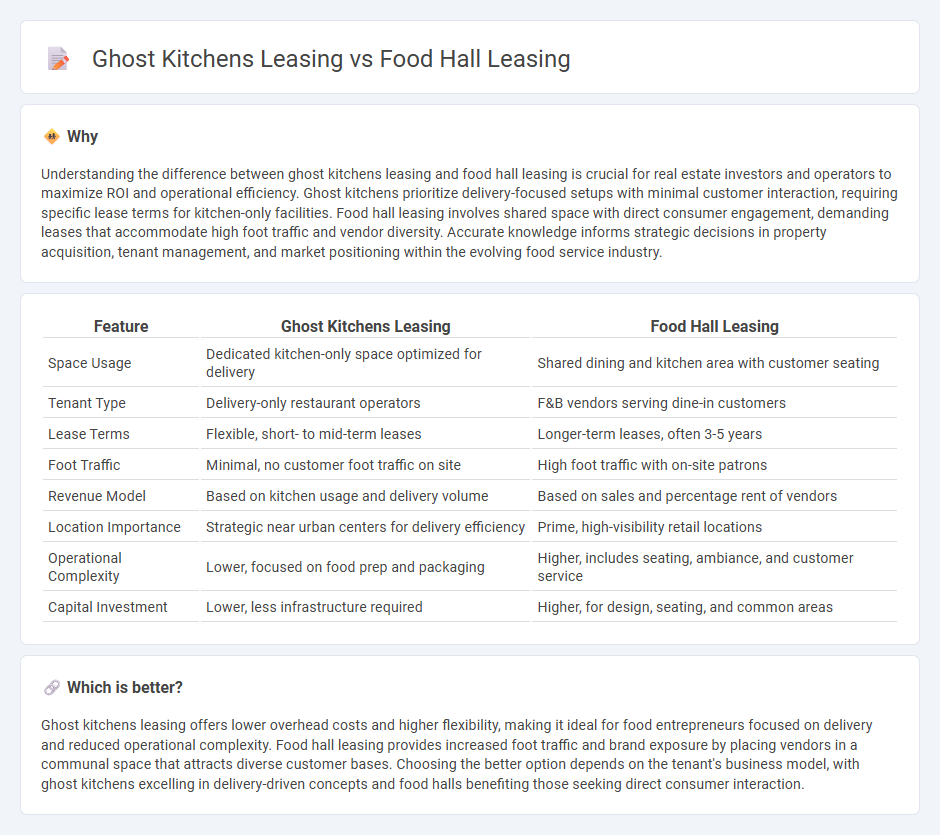
Ghost kitchens leasing offers flexible, low-overhead spaces tailored for delivery-only food businesses, capitalizing on the rising demand for online food orders. Food hall leasing provides a dynamic environment with diverse vendors sharing a communal space, enhancing customer foot traffic and in-person dining experiences. Explore how these leasing options can strategically boost your real estate investment and food business growth.
Why it is important
Understanding the difference between ghost kitchens leasing and food hall leasing is crucial for real estate investors and operators to maximize ROI and operational efficiency. Ghost kitchens prioritize delivery-focused setups with minimal customer interaction, requiring specific lease terms for kitchen-only facilities. Food hall leasing involves shared space with direct consumer engagement, demanding leases that accommodate high foot traffic and vendor diversity. Accurate knowledge informs strategic decisions in property acquisition, tenant management, and market positioning within the evolving food service industry.
Comparison Table
| Feature | Ghost Kitchens Leasing | Food Hall Leasing |
|---|---|---|
| Space Usage | Dedicated kitchen-only space optimized for delivery | Shared dining and kitchen area with customer seating |
| Tenant Type | Delivery-only restaurant operators | F&B vendors serving dine-in customers |
| Lease Terms | Flexible, short- to mid-term leases | Longer-term leases, often 3-5 years |
| Foot Traffic | Minimal, no customer foot traffic on site | High foot traffic with on-site patrons |
| Revenue Model | Based on kitchen usage and delivery volume | Based on sales and percentage rent of vendors |
| Location Importance | Strategic near urban centers for delivery efficiency | Prime, high-visibility retail locations |
| Operational Complexity | Lower, focused on food prep and packaging | Higher, includes seating, ambiance, and customer service |
| Capital Investment | Lower, less infrastructure required | Higher, for design, seating, and common areas |
Which is better?
Ghost kitchens leasing offers lower overhead costs and higher flexibility, making it ideal for food entrepreneurs focused on delivery and reduced operational complexity. Food hall leasing provides increased foot traffic and brand exposure by placing vendors in a communal space that attracts diverse customer bases. Choosing the better option depends on the tenant's business model, with ghost kitchens excelling in delivery-driven concepts and food halls benefiting those seeking direct consumer interaction.
Connection
Ghost kitchens and food hall leasing are interconnected through their shared reliance on flexible commercial real estate strategies to meet evolving food service demands. Both models leverage smaller, adaptable lease spaces within high-traffic urban locations, optimizing cost efficiency and operational scalability. This alignment drives increased demand for innovative real estate offerings tailored to multi-tenant culinary environments.
Key Terms
**Food Hall Leasing:**
Food hall leasing offers established operators the opportunity to secure premium retail spaces within high-traffic, community-centered venues designed for diverse culinary experiences. Compared to ghost kitchens, food hall leases typically involve fixed-term contracts with physical storefronts, higher visibility, and direct customer engagement. Explore the benefits and considerations of food hall leasing to optimize your restaurant investment strategy.
Percentage Rent
Percentage rent in food hall leasing typically involves tenants paying a base rent plus a percentage of gross sales, aligning landlord income with tenant performance, which is common in high-footfall retail environments. Ghost kitchen leases often emphasize fixed rent with minimal or no percentage rent due to their low overhead nature and absence of direct customer interaction on site. Explore the nuances of percentage rent structures in these leasing models to optimize your commercial real estate strategy.
Common Area Maintenance (CAM) Charges
Food hall leasing often includes Common Area Maintenance (CAM) charges that cover shared space upkeep, utilities, and facility services, typically apportioned based on leased square footage. Ghost kitchen leases may have lower or more specialized CAM fees due to limited customer-facing areas and reduced communal space usage, emphasizing utility and equipment maintenance. Explore detailed comparisons of CAM cost structures to optimize your commercial kitchen leasing strategy.
Source and External Links
FOOD HALLS: Legal Risk Considerations - This article discusses the mix of short-term licenses and long-term leases used by food hall operators to manage risk and adapt to market trends.
Food Hall Fever: Business & Legal Considerations - The article highlights the differences between restaurant leases and food hall licenses, focusing on the cost-saving aspects for both owners and vendors.
Food Halls Hold Special Legal Considerations for Landlords - This publication addresses legal issues that landlords face when structuring and documenting food hall projects.
 dowidth.com
dowidth.com